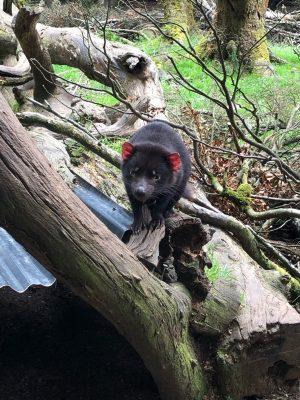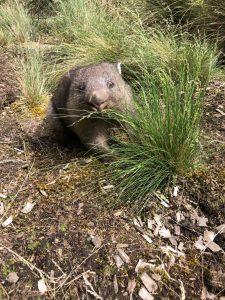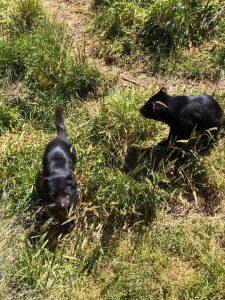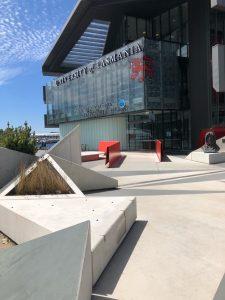-
About
- Leadership & Faculty
- News & Events
-
Academics
- Graduate
- Advanced Clinical Training
- Continuing Education
-
Student Life
-
Research
-
Hospitals & Clinics
- Emergency Care
- Hospital Services
-
Community Outreach
- Volunteer
How to Live Your Best Life Down Under – Out in the Field vs. Inside the Office
Natalie Bauer, MCM’19 Shares her Winter Externship Experience with Devils at Cradle Wildlife Sanctuary and Institute for Marine and Antarctic Studies in Tasmania

Tasmania may seem like a random place to work, but it is a hidden gem for conservation related jobs. There is so much to offer on this island found below the mainland of Australia. It has a unique range of endemic species and is located just a boat ride away from Antarctica. The endless coastlines offer plenty of research opportunities focused on marine life.
Out in the Field: A Day in the Life of a Devils at Cradle Volunteer
As soon as I arrive at the facility, I head straight back to the behind the scenes area and begin the joey morning routine. This involves socializing the baby marsupials and preparing their food. There are two rescued wombats and a padymelon that were found in the pouch of their mothers after being hit by a car. Additionally, there are two baby devils and three baby quolls that are part of the breeding programs. The wombats and padymelon get oats and vegetables, while the devils and quolls get small chunks of meat with warm milk poured on top. After taking Pancake, the older of the two wombats, for a walk around the back of the park, I start on the main park routine. This consists of filling water bowls and cleaning up feces and leftover bones for half of the park. Around midday I help out with the joey tour. This means preparing 3 bottles of calcium powder and warm water for the 2 wombats and padymelon. Then I hold the joeys for visitors to pet while explaining more about possible release back into the wild and the captive population insurance. In the afternoon, I usually help out with a few tasks, such as setting up or taking down camera traps, enclosure maintenance, and stocking the shelves of the small store selling local products. Then it is time to feed the devils and quolls for the night. There is a complicated system in place to mimic their natural diets of the gorging and fasting. It’s an exhausting day, but well worth it to increase the chance of long-term survival for these endangered species.
5 Helpful Tips
1. Before starting the day at Devils at Cradle, always make sure to check the weather forecast because the temperature fluctuates a lot at Cradle Mountain. When working outside, bring a rain jacket and hat just in case.
2. Review background material covering the Devil Facial Tumor Disease so you are ready for questions.
3. Be prepared for the gruesome act of feeding the carnivorous devils.
4. Always keep your eyes on the devils while inside their enclosures. They like to sneak up on you! Keep in mind that the white patches of fur represent fingerprints to identify them.
5. Look out for spiders and snakes!
Inside the Office: A Day in the Life of an IMAS, University of Tasmania Intern
The Institute for Marine and Antarctic Studies (IMAS) has two locations in Hobart. One is found at the waterfront and the other is in Taroona. Both offer scenic views of the sea, but different vibes from the city co
mpared to the country. There is an unlimited array of projects being done at IMAS, and it is truly incredible how much research is conducted by this one institution. I was assigned to two distinct studies, so I usually alternated my time spent on each day by day. Dr. Emily Ogier, Fisheries Social Science Research Fellow at IMAS requested that I compose case study reports of specific marine bioregions based on ecosystem fisheries management. This required reading a lot of literature and organizing notes into a comprehensive template. Meanwhile Dr. Gretta Pecl, Director of the Centre for Marine Socioecology at the University of Tasmania, created the citizen science initiative of Redmap which encourages fishers and divers all over Australia to send in photographic observations of species observed outside their expected distribution. This geographic representation of species shifting where they live to meet their preferred environmental conditions demonstrates the varied effects of climate change. My role in this project was to help build their social media pages and also analyze the audience outreach. This was a little bit more fun because I could find interesting news articles or entertaining videos to post on the Facebook page. I also contributed to the website resources by interviewing scientists for the newsletter and drafting a few of my own articles on topics requested by viewers, such as how to differentiate between two similar species.
5 Helpful Tips
1. Create a schedule to divide up your list of assigned tasks. This makes the workload seem less daunting and more approachable.
2. Switch to something else if you are losing motivation.
3. Don’t be afraid to ask for clarification from your advisor if you are confused.
4. Think about the big picture goal of the project.
5. Bring your mug for coffee breaks!



